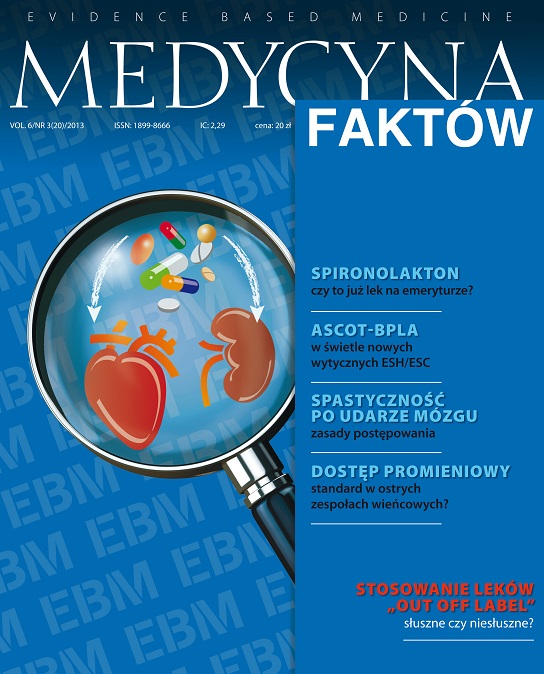Aceklofenak – zastosowanie u pacjentów z bólem przewlekłym w przebiegu: choroby zwyrodnieniowej stawów, zesztywniającego zapalenia stawów kręgosłupa i reumatoidalnego zapalenia stawów Opis serii przypadków
##plugins.themes.bootstrap3.article.main##
Abstrakt
Aceklofenak należy do niesteroidowych leków przeciwzapalnych (NLPZ) o silnym działaniu przeciwbólowym i przeciwzapalnym. Zaliczany jest do selektywnych inhibitorów cyklooksygenazy 2 (COX2). Charakteryzuje się unikalnym, korzystnym działaniem na metabolizm chrząstki stawowej. Zgodnie z charakterystyką produktu leczniczego jest wskazany w leczeniu bólu i stanów zapalnych w przebiegu choroby zwyrodnieniowej stawów (ChZS), reumatoidalnego zapalenia stawów (RZS) oraz zesztywniającego zapalenia stawów kręgosłupa (ZZSK).
##plugins.themes.bootstrap3.article.details##
Jak cytować
Kucia, H., & Sękowska , A. (2013). Aceklofenak – zastosowanie u pacjentów z bólem przewlekłym w przebiegu: choroby zwyrodnieniowej stawów, zesztywniającego zapalenia stawów kręgosłupa i reumatoidalnego zapalenia stawów. Medycyna Faktów , 6(3(20), 16-22. Pobrano z https://journalsmededu.pl/index.php/jebm/article/view/2402
Numer
Dział
Artykuły
Copyright © by Medical Education. All rights reserved.
Bibliografia
1. Dooley M., Spencer C.M., Dunn C.J.: Aceclofenac: a reappraisal of its use in the management of pain and rheumatic disease. Drugs 2001; 61: 1351-1378.
2. Hinz B., Brune K.: Pain and osteoarthritis: new drugs and mechanisms. Curr. Opin. Rheum. 2004; 16(5): 628-633.
3. Dingle J.T., Parker M.: NSAID stimulation of human cartilage matrix synthesis – a study of the mechanism of action of aceclofenac. Clin. Drug. Invest. 1997; 14: 353-362.
4. Blot L., Marcelis A., Devogelaer J.P., Manicourt D.H.: Effects of diclofenac, aceclofenac and meloxicam on the metabolism of proteoglycans and hyaluronan in osteoarthritic human cartilage. Br. J. Pharmacol. 2000; 131: 1413-1421.
5. Legrand E.: Aceclofenac in the management of inflammatory pain. Expert Opin. Pharmacother. 2004; 5(6): 1347-1357.
6. Pareek A.,Chandurkar N.: Comparison of gastrointestinal safety and tolerability of aceclofenac with diclofenac: a multicenter, randomized, double- blind study in patients with knee osteoarthritis. Gastroenterology 2013; 29(7): 849-859.
7. Hinz B., Rau T., Auge D. et al.: Aceclofenac spares cyclooxygenase 1 as a result of limited but sustained biotransformation to diclofenac. Clin. Pharmacol. Ther. 2003; 74: 222-235.
8. Kompendium leczenia bólu. Malec-Milewska M., Woroń J. (red.). Medical Education Sp. z o.o., Warszawa 2012.
9. Rupiński R.: Aceklofenak – działanie chondroprotekcyjne w chorobie zwyrodnieniowej stawów. Medycyna Faktów 2013; 6(18).
10. Maneiro E., López-Armada M.J., Fernández-Sueiro J.L. et al.: Aceclofenac increases the synthesis of interleukin 1 receptor antagonist and decreases the production of nitric oxide in human articular chondrocytes. J. Rheumatol. 2001; 28(12): 2692-2699.
11. Henrotin Y., de Leval X., Mathy-Hartet M. et al.: In vitro effects of aceclofenac and its metabolites on the production by chondrocytes of inflammatory mediators. Inflamm. Res. 2001; 50: 391-399.
12. Choroby wewnętrzne 2013. Gajewski P. (red.). Medycyna Praktyczna 2013.
13. Rupiński R.: Wpływ aceklofenaku na chrząstkę stawową na tle wpływu innych niesteroidowych leków przeciwzapalnych. Medycyna Faktów 2013; 6(18).
2. Hinz B., Brune K.: Pain and osteoarthritis: new drugs and mechanisms. Curr. Opin. Rheum. 2004; 16(5): 628-633.
3. Dingle J.T., Parker M.: NSAID stimulation of human cartilage matrix synthesis – a study of the mechanism of action of aceclofenac. Clin. Drug. Invest. 1997; 14: 353-362.
4. Blot L., Marcelis A., Devogelaer J.P., Manicourt D.H.: Effects of diclofenac, aceclofenac and meloxicam on the metabolism of proteoglycans and hyaluronan in osteoarthritic human cartilage. Br. J. Pharmacol. 2000; 131: 1413-1421.
5. Legrand E.: Aceclofenac in the management of inflammatory pain. Expert Opin. Pharmacother. 2004; 5(6): 1347-1357.
6. Pareek A.,Chandurkar N.: Comparison of gastrointestinal safety and tolerability of aceclofenac with diclofenac: a multicenter, randomized, double- blind study in patients with knee osteoarthritis. Gastroenterology 2013; 29(7): 849-859.
7. Hinz B., Rau T., Auge D. et al.: Aceclofenac spares cyclooxygenase 1 as a result of limited but sustained biotransformation to diclofenac. Clin. Pharmacol. Ther. 2003; 74: 222-235.
8. Kompendium leczenia bólu. Malec-Milewska M., Woroń J. (red.). Medical Education Sp. z o.o., Warszawa 2012.
9. Rupiński R.: Aceklofenak – działanie chondroprotekcyjne w chorobie zwyrodnieniowej stawów. Medycyna Faktów 2013; 6(18).
10. Maneiro E., López-Armada M.J., Fernández-Sueiro J.L. et al.: Aceclofenac increases the synthesis of interleukin 1 receptor antagonist and decreases the production of nitric oxide in human articular chondrocytes. J. Rheumatol. 2001; 28(12): 2692-2699.
11. Henrotin Y., de Leval X., Mathy-Hartet M. et al.: In vitro effects of aceclofenac and its metabolites on the production by chondrocytes of inflammatory mediators. Inflamm. Res. 2001; 50: 391-399.
12. Choroby wewnętrzne 2013. Gajewski P. (red.). Medycyna Praktyczna 2013.
13. Rupiński R.: Wpływ aceklofenaku na chrząstkę stawową na tle wpływu innych niesteroidowych leków przeciwzapalnych. Medycyna Faktów 2013; 6(18).
